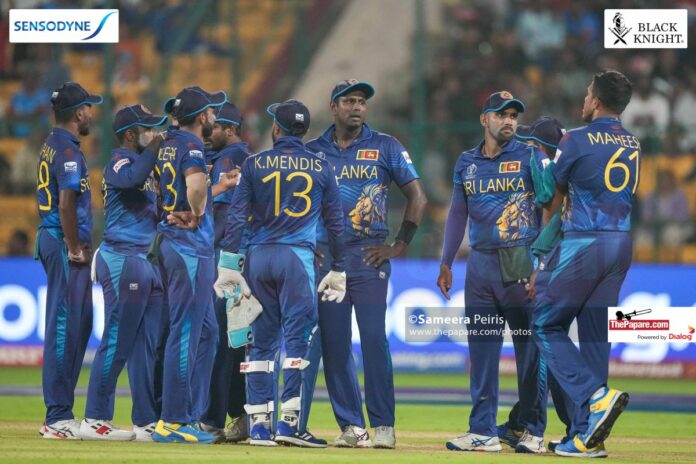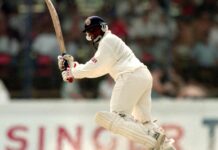Sri Lanka’s painful World Cup campaign ended early this week in the beautiful southern Indian city of Bangalore leaving many questions to be answered and leaving lots of uncertainties. These issues are nothing new. They have existed for a while, and we have failed pathetically to address them, and the result of the World Cup was inevitable.
One of the main issues affecting the team is that they are unable to bat 50 overs. That has been an age-old problem running back to 2015 when Sri Lanka infamously crashed out of the World Cup in Sydney with a dramatic collapse.
Dimuth Karunaratne has become a sort of World Cup specialist having featured in all three editions of the sport – 2015, 2019 and 2023. But in between he makes few appearances in the 50 over format.
The Test captain’s role was to bat through the innings, but he seemed to be keeping an eye on the Strike Rate and his dismissals were bizarre and unbecoming of someone who was expected to steady the innings. If the selectors had told him to keep an eye on the Run Rate, obviously they had lost the plot.
The choice of Dhananjaya de Silva at number six has surprised many especially as most teams had chosen a power hitter in that position be it Glenn Maxwell, Suryakumar Yadav or David Miller.
DDS is a classical type of player with great hands and his bowling abilities make him a permanent fixture in the side. But given the demands of modern-day cricket where teams are looking to score 100 plus in the last ten overs, he becomes a square peg in a round hole. He is far better at the top order.
Literally, in Sri Lanka we don’t have a power hitter. When we thought that Thisara Perera’s time had expired and benched him, we didn’t prepare someone who could clear the boundary. That was a mistake, and it came back to hurt and haunt us during the World Cup.
There were too many ‘all-round’ options in the side. This has been a recipe for disaster as we found out during the tour of India early this year, but we failed to learn our lessons.
Banking on the success of some of these ‘all-rounders’ on poor tracks at home, we picked them for the World Cup and their roles were minimal throughout the campaign. Instead, we would have been far better had we picked a couple of additional batters for too many of them were out of form and we had run out of options. Ideally Angelo Mathews and Dhananjaya de Silva should have been our all-rounders but clearly the selectors backed their failed policies.
Need proof? Well, Chamika Karunaratne played three games, picked up no wickets and contributed eight runs with the bat. Dunith Wellalage didn’t fare better either.
Sri Lanka’s catching was awful throughout the tournament. To spill 16 catches in the sport’s showpiece event shows how much work that needs to be done as regards to fielding moving forward. Sri Lanka were easily the worst fielding unit in the tournament. Some of the dropped catches really hurt them.
Since 2015, SLC has hired various experts including Jonty Rhodes, but fielding has made little progress. After every cricketing debacle, the debate is on fielding, but parties concerned seem to worry so little to address this issue.
- A few remedial measures moving forward after World Cup debacle
- Sri Lanka’s World Cup campaign back on track
All the fault doesn’t lie with coaches and those who are picking them. Players themselves need to take the blame for fielding is a discipline where you can make so much progress if you work hard enough. Former captain T.M. Dilshan is a classic example. With sheer hard work he went onto become one of the best fielders in the world. It’s a pity that some of the young players in the side remain sloppy in fielding and that literally sums up our cricket.
Obviously, Dilshan Madushanka’s heroics was a silver lining during the six weeklong tournament. Playing in his first World Cup, he emerged as the highest wicket taker with 21 scalps to his name. But as Waqar Younis pointed out, Sri Lanka’s campaign would have been far better had he got some backup.
Sri Lanka’s next best bowler was Kasun Rajitha, who finished with eight victims. Much was expected from Maheesh Theekshana in the absence of Wanindu Hasaranga, but he managed just six wickets after eight games, as many as Angelo Mathews, who accounted for same number of victims in five games.
Sadeera Samarawickrama with 373 runs with a hundred and two half-centuries and Pathum Nissanka with 332 runs and four half-centuries were the mainstay of Sri Lanka’s batting but they needed to do much more with rest of the batting failing to fire. Kusal Perera scored two half-centuries but on both occasions threw away his wicket.
It was a shambolic campaign by the former champions. Very little was going their way in India. Bit more planning would have ensured that this was a far better campaign. A first ever World Cup defeats to Bangladesh and Afghanistan sum up the story. There’s a long way back for Sri Lanka to get back to winning ways.























